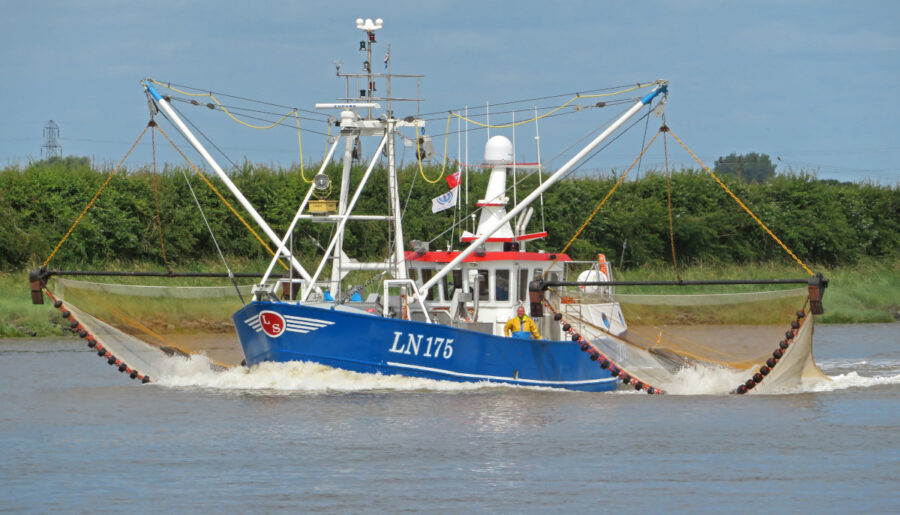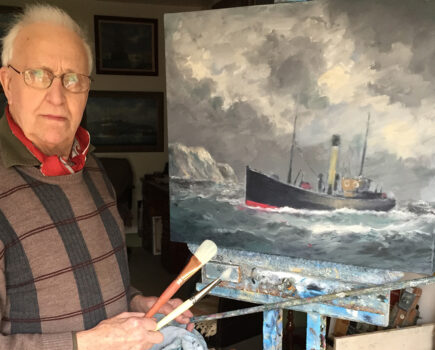A distinguished old lady has returned to the Wash after a facelift, some fetching changes to her topsides and other surgical reconstruction. John Worrall reports
Lynn Princess – or some of her – is 50 years old. Built in Holland, she fished from there for a decade or two, before being acquired in the early 1990s by Lynn Shellfish (known at the time as Heiploeg & Lynn) of King’s Lynn. There, among the rest of the 60-odd-boat Wash fleet, she worked the usual Wash fisheries of mussels, cockles and shrimps, along with occasional whelking and some scalloping further afield.
In some quarters, she might have been thinking about retirement, but she’s 16.5m long, and that is the crucial point, because these days, no new boats above 14m are allowed to be used under a Wash entitlement, and she couldn’t therefore be replaced by something of similar size – and so she’s undergone a comprehensive rebuild.
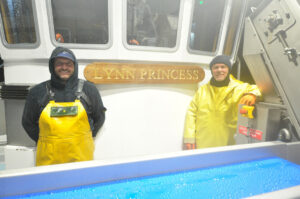
Skipper Andrew Ashton, left, and crewman Paul Greer.
Most of the work was done by the company itself, on the quay beside its processing factory, except for that for which it didn’t have the expertise, which came down mostly to hydraulics.
“When we took her out of the water, we were only intending to replace the topsides,” said Steven Williamson of Lynn Shellfish. “But then, when the plates were tested, a lot needed replacing, and so in the end, we decided to do them all.”
The only original parts left are the keel, the engine beds, most of the ribs, part of the deck, the shaft tube and the rudder.
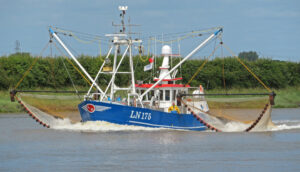
The restored Lynn Princess LN 175, back to shrimping in September.
The boat has a new 193kW Doosan main engine, a 200hp Doosan auxiliary to power the hydraulics, and a 45kVA JCB generator, all of which the company installed itself, along with all the new electronics.
“But the hydraulics were supplied and fitted by Dutch company Couperus Hydrauliek BV,” said Steven Williamson. “There is a seven-winch system, and the individual winches, instead of being on deck in front of the wheelhouse, are below deck and forward, underneath the new A-frame. This is the fifth boat of ours on which Couperus has supplied and fitted the complete hydraulic and winch system.”
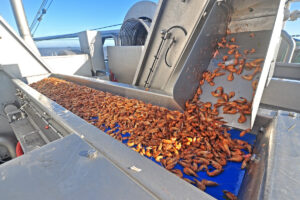
The new, fully automated shrimp handling and processing system.
The project received EMFF funding arranged by funding consultant David Guy, who said it had been a pleasure working with Lynn Shellfish.
“It is really good to see the EU funds going towards such a worthwhile project that will benefit the fishery and the local community, including employment,” he said.
Lynn Princess started work again in September, and at the end of the month, Fishing News went for a day’s shrimping with skipper Andrew Ashton and crewman Paul Greer, to see this reborn unit in action.
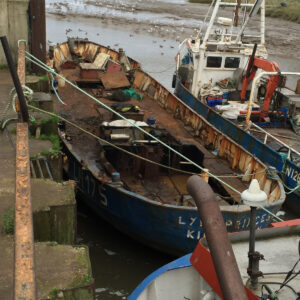
The vessel was taken right back to the hull before rebuilding work began. (Photo: Lynn Shellfish)
The early morning start, on a big tide, was from South Quay on the river Great Ouse itself, rather than from the Fisher Fleet, where most of the Lynn boats tie up. The Fisher Fleet, a muddy cutting off the main river, is conveniently located between the town’s two processing factories, but it is more tide-bound – accessible for not much more than an hour either side on the neaps – and also a bit crowded, and certainly not the place for a new paint job to stay unblemished. In any case, Lynn Princess is bigger than the other local boats, and although her draught of 1.8m is no more than most of theirs, she appreciates the space and greater flexibility.
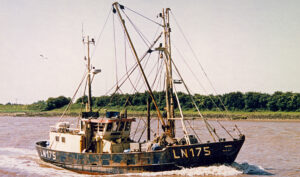
Lynn Princess before her large-scale rebuild project.
By the time the sun came up to make a glorious autumn morning, an hour’s steaming saw her out of the river and off Heacham on the eastern side of the Wash, where she spent two or three hours towing up and down, before moving north and west with the ebb.
Historically, Wash shrimping has tended to have been done more from King’s Lynn than from Boston – although both ports do it – because shrimps have tended to be found more on the eastern side. That may have something to do with the fact that the Great Ouse is by some way the biggest of the four rivers feeding into the Wash, and back in the day, when those rivers carried much more tasty effluent, there was more shrimp sustenance to be had there. In relative terms, there may still be.
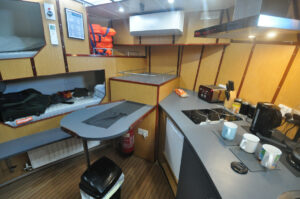
There’s a decent-sized galley below…
On the other hand, the main Wash cockle beds are more to the west (and so Boston boats tend to do more cockling than shrimping), and these days, with cockles now hand-worked, rather than dredged, that fishery lasts well into the autumn, which is also the traditional peak for shrimping. So at that time of year, boats have the two options, and can work a combination of both if necessary. On the bigger tides, which allow more time dried out and picking, a day’s cockling might be viable when conditions are too choppy for comfortable shrimping.
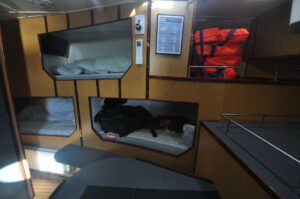
… with three berths, each with TV.
But conditions on this particular autumn morning were ideal, and in the full light of day, Lynn Princess was looking good.
The first impression is that the wheelhouse, by comparison with other Wash boats, is a bit Starship Enterprise (with a fetching ‘Lynn Shellfish’ motif on the floor by way of welcome – a nice touch), but then, she is effectively new, and technology has moved rapidly in recent years.
Screens abound, facing the skipper’s chair, which has an adjacent control console, while a traditional wheel is just forward, to be worked from a standing position.
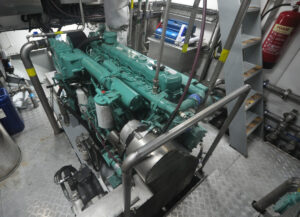
The main engine is a 193kW Doosan…
“The engine controls, by Kobelt, are electronic,” said Andrew Ashton. “And it’s a dual system, worked from the central console when shrimping, and from the forward side of the wheelhouse when cockling.”
He ran through the rest of the kit. “The main sounder is Koden, and the radar, with 3D ground discrimination, is by TimeZero. The radar and plotter are run by one PC, and the ground discrimination by another. The radar is digital and uses less power, and also gives a constant picture, rather than waiting for the sweep of an analogue scanner. You get a picture on the screen of the AIS target, and also the track line. It’s powerful, too – it goes up to 96 miles – although here in the Wash, the usual range we need is about one and a half to six miles.
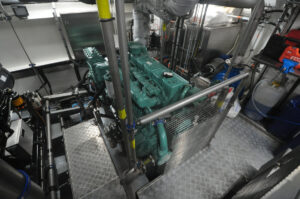
… the auxiliary is a 200hp Doosan…
“The compass is JRC, the steering and autopilot are Navitron, and communications are Sailor. The searchlight on the front of the wheelhouse was made by Seematz.”
The screens include feeds from engineroom cameras for the main and auxiliary engine, and for the winch room.
The seven below-deck winches – three working the derricks and beams each side, and one to bring the catch up from the fishroom – each have their own wheelhouse toggle controls.
“And then, the most important bit,” said Andrew, “is the at-sea entertainment system by Fusion: a three-centre music system with stations in the wheelhouse, in the galley and out on deck. And the satellite television signal (for screens in each of the three berths below) is by Sea Tel.”
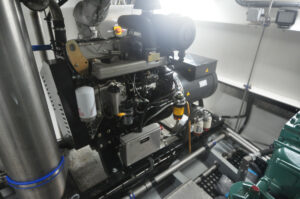
… and there’s a 45kVA JCB generator.
The galley and accommodation, which is below and aft of the wheelhouse, includes kitchen facilities and a shower and toilet.
But actually, the ‘most important bit’, on this particular day anyway, was the whizzy shrimp handling and processing system out on deck just forward of the wheelhouse – an orderly convolution of hoppers, elevators, pipes, conveyor, cooker and particularly ingenious riddle, together with a by-catch ejection arrangement leading out through the scupper – and all of it in shiny stainless steel.
Developed in Holland and supplied by De Boer RVS of Makkum, it’s a system now in use on many Dutch shrimp boats – though those boats are mostly bigger, of 24m or so, and the set-up on Lynn Princess has the shortest riddle the company makes. It is also the debut for the kit on this side of the North Sea, but then, the Wash shrimp fishery is the biggest – indeed the only significant one – in the UK.
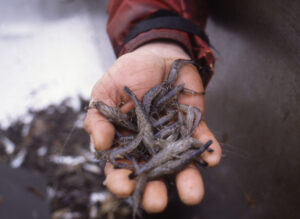
Brown shrimp, nice and straight. They don’t curl until they’re cooked.
The shrimp handling process is almost entirely automated, from the moment the codend is emptied into the hopper, until the cooked shrimps are boxed in the fishroom. The stages in between are a collective refinement of established shrimp processing in what, at first glance, is a tangle of kit through which the shrimp stream passes – rising, falling, doubling back and swirled along where necessary on the water-slide principle. The whole arrangement takes up the central part of the deck, in full view of the wheelhouse.
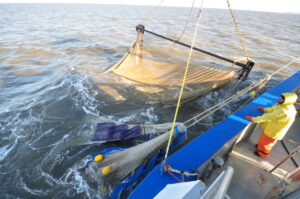
The process starts with the hauling aboard of the codend…
When the beams are raised, the codends are hauled aboard in turn and emptied into the respective sides of the transverse hopper, which funnels to a sump out of which an elevator takes the catch up to a pipe, in which jetted water surfs it into the riddle.
The riddle is the particularly clever bit, comprising a couple of horizontal, slowly contra-rotating cylinders, one inside the other, made up of bars with gaps of varying sizes. The catch enters one end of the inner cylinder, where gaps between circumferential bars allow shrimps through while retaining bigger by-catch – mostly small whiting. This is moved through by baffles and the screw thread of the bars to the other end, to channel into a duct of fast-moving water that takes it straight overboard through the scuppers.
The outer cylinder, with smaller-gauge gaps in two sections of bars – lateral and circumferential – allows small shrimps to pass through. These are also channelled to the duct and the scuppers. Up to this point, apart from the compression of the codend, shrimps have had no significant threat to their wellbeing, and De Boer claims that most re-enter the sea alive (where gulls are waiting, but that’s another matter).
The retained and marketable-sized shrimps, which are what it’s all about, enter another line of piped water, which takes them to another hopper and elevator to be lifted into the diesel-fired cooker with water at 95-99°C, through which they are conveyed for exactly three minutes. From this, they emerge down a short chute onto a slow conveyor, cooked to a turn. There, the occasional pink shrimp can be picked out by hand (there used to be a pink shrimp fishery, and the pinks are still there – but their market no longer is). There aren’t many – pinks are found in deeper water than browns. The flow then tips down to the fishroom by another vertical chute, from which it is released into boxes.
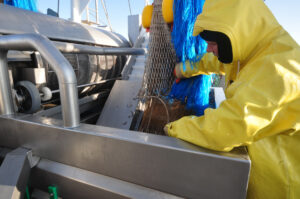
… which is emptied into the hopper.
The final part of the process is back at the quay, where the boxes are raised, several at a time, by the seventh winch to deck level for landing.
This is a comfortable two-man operation, with less labour than with older technology, and certainly with no baskets of shrimps cluttering the deck. And in addition to the better survival chances for by-catch, the use of nets of Dyneema fibre, supplied by CIV Den Oever, with their much greater strength relative to filament size, gives undersized shrimps improved chances of escaping the net in the first place.
Lynn Princess is a boat remade for the Wash which, though bigger than the rest of the fleet, retains flexibility on the shoals. Its engines consume about 350 litres on a 12-hour trip, and for those occasional scalloping days further north, when the shrimps aren’t doing much and the cockles haven’t started, she’ll do 10 trips at that rate before bunkering.
But the Wash fisheries pattern continues to change. Traditionally, it was mussels in winter, pink and brown shrimps in spring, cockles in summer, and the bigger brown shrimp fishery in autumn, up to Christmas.
But for a year or two now, mussels haven’t really featured (though there are tentative signs of revival), while the market for pink shrimps has disappeared – which is perhaps fortunate in that pink shrimps are anyway associated with reefs built by Ross worm Sabellaria spinulosa, a protected feature under the Habitats Directive, and therefore a feature of the Wash SPA to be avoided.
Returning to port at 8pm that night, by then in the dark and heavy rain, Lynn Princess went first to Boal Quay, on the river just away from the town centre, where she was met by a lorry to take the catch boxes back round to the factory.
With higher winds forecast for the following day, Andrew had decided that they would have a day’s cockling instead, because big tides would allow time on the sand for the two of them to hand-pick the daily 2t quota, and there is plenty of room on deck for the tonne bags. So the beam trawls were, in turn, swung on the quay and released from their cables by a quick couple of turns from a wrench. There they were left – not the sort of things to be easily nickable – before Lynn Princess headed back to her South Quay mooring.

